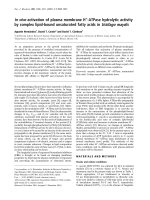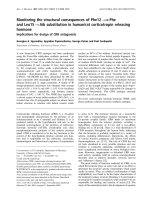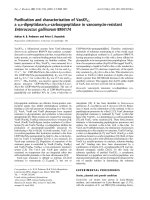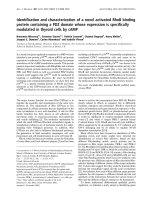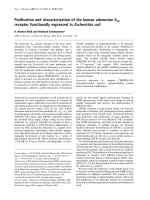Báo cáo y học: "In vivo bactericidal activities of Japanese rice-fluid against H. pylori in a Mongolian gerbil model" ppsx
Bạn đang xem bản rút gọn của tài liệu. Xem và tải ngay bản đầy đủ của tài liệu tại đây (552.88 KB, 6 trang )
Int. J. Med. Sci. 2007, 4
203
International Journal of Medical Sciences
ISSN 1449-1907 www.medsci.org 2007 4(4):203-208
©Ivyspring International Publisher. All rights reserved
Research Paper
In vivo bactericidal activities of Japanese rice-fluid against H. pylori in a
Mongolian gerbil model
Satoshi Ishizone
1
, Fukuto Maruta
1
, Kazufumi Suzuki
1
, Shinichi Miyagawa
1
, Masahiko Takeuchi
2
, Kiyomi
Kanaya
3
, Kozue Oana
4
, Masayoshi Hayama
4
, Yoshiyuki Kawakami
4
, Hiroyoshi Ota
4
1. Department of Surgery, Shinshu University School of Medicine, Matsumoto, Japan;
2. Agricultural Technology Institute, Nagano Farmer’s Federation, Japan;
3. Nagano Kohno, Co., Ltd., Japan;
4. Department of Biomedical Laboratory Sciences, School of Health Sciences, Shinshu University School of Medicine, Japan
Correspondence to: Dr. Satoshi Ishizone, Department of Surgery, Shinshu University School of Medicine, Asahi 3-1-1, Matsumoto,
390-8621, Japan. E-mail:
Received: 2007.06.11; Accepted: 2007.08.09; Published: 2007.08.10
Purpose: The antibiotic effect of rice-fluid on Helicobacter pylori infection was investigated using a Mongolian
gerbil model.
Methods: Gerbils were divided into four groups: H. pylori -infected, rice-fluid-treated animals (group A); H. py-
lori -infected, untreated animals (group B); uninfected, rice-fluid-treated animals (group C); and uninfected, un-
treated animals (group D). Group A and B animals were killed 14 weeks after H. pylori infection and group C
and D animals were killed at the same age. The stomachs were examined for histology,
5'-bromo-2'-deoxyuridine (BrdU) labeling, and the bacterial burden. Serum anti-H. pylori antibody titers were
also tested.
Results: The positive incidence of H. pylori -culture was 25 and 84 % in groups A and B, respectively (p<0.01).
Both the degree of inflammation and the BrdU labeling index in group A were significantly lower than those in
group B.
Conclusions: Rice-fluid showed an antibiotic effect on H. pylori and an anti-inflammatory effect on the H. pylori
-associated gastritis.
Key words: Japanese Rice-fluid, Helicobacter pylori, Mongolian gerbil, eradication, prevention
1. Introduction
Helicobacter pylori is the most important etiologi-
cal agent of chronic gastritis and peptic ulcer and it is
also known to increase the risk of gastric cancer [1-4].
The Mongolian gerbil is a useful animal model to in-
vestigate human gastric disorders: H. pylori easily in-
fects the stomach of Mongolian gerbils, thereby in-
ducing human-mimicking gastritis, peptic ulcer and
intestinal metaplasia in the stomach. In addition, this
animal model can develop gastric adenocarcinoma by
inoculation of H. pylori [5].
Accumulating evidence has demonstrated that
the eradication of H. pylori in the stomachs by the ad-
ministration of oral antimicrobial agents results in the
resolution of H. pylori-associated gastroduodenal dis-
eases [6-8]. In addition, the eradication of H. pylori is
also reported to decrease the risk of gastric carcino-
genesis in Mongolian gerbils [9, 10]. Triple combina-
tion therapy, using two antibacterial antibiotics and a
proton pump inhibitor, achieved a high eradication
rate [11-13]. However, such combination therapy does
not always successfully eradicate H. pylori. In recent
years, the increased occurrence of clarithromycin-
and/or metronidazole-resistant strains of H. pylori has
become a problem [14, 15]. In addition, antibiotics
cannot be used due to drug allergies in some patients
and the antibiotic therapy is also occasionally associ-
ated with adverse events. Furthermore, it is consid-
ered to be inappropriate to administer antimicrobial
agents long-term to prevent H. pylori infection. Con-
sequently, it is important to investigate the use of
non-antibiotic therapies for H. pylori infection, which
are highly effective and safe.
Many investigators have researched
non-antibiotic therapies for H. pylori infection [16-21],
utilizing plant extracts and constituents, probiotics,
antioxidants, and so on. However, regarding
rice-extract, no studies have yet been reported except
ours [22]. In our previous study using an animal
model, a Rice Power Extract (RPE) showed a suppres-
sive effect on gastric mucosal inflammation, but it did
not show any significant decrease in the viable H. py-
lori obtained from stomach samples [22]. This time, we
employed a different type of rice extract, Japa-
nese-Rice-Fluid (JRF, patent number 3655880). The JRF
has already been reported to show a strong in vitro
bactericidal activity against H. pylori [23] and there
were no resistant strains of H. pylori [23]. In addition, it
Int. J. Med. Sci. 2007, 4
204
is easily manufactured and has recently been adopted
as an ingredient in several kinds of liquid food as the
main supplemental ingredient, and it is commercially
available all over Japan.
In this study, we investigated the antibiotic effect
of JRF on H. pylori infection in vivo and its
anti-inflammatory effects on the H. pylori-induced
gastritis, using a Mongolian gerbil model.
2. Materials and Methods
Animals
Specific pathogen-free male Mongolian gerbils
(Meriones unguiculatus) (MGS/Sea) (Seac Yoshitomi,
Ltd., Fukuoka, JAPAN), 7 weeks old, were housed in
plastic cages with hard wood chips in an
air-conditioned biohazard room for infection with a 12
hours light-12 hours dark cycle. They were given food
(CE-2, Clea Japan Inc., Tokyo, Japan) and water or the
JRF as drinking water in bottles ad libitum. Approval
for this study was obtained prior to experimentation
from the animal ethics committee, and all procedures
were performed in compliance with Guidelines for the
Care and Use of Laboratory Animals in Shinshu Uni-
versity.
Bacterial inoculation
H. pylori (ATCC43504, CagA+, VacA+, American
Type Culture Collection, Rockville, MD, USA) was
grown in Brucella broth (Becton Dickinson, Cockeys-
ville, MD, USA) containing 10 % v/v horse serum at
37 °C under microaerophilic conditions (15% CO
2
) at
high humidity for 40 hours with gentle shaking (150
rpm). After each gerbil had fasted for 24 hours, sam-
ples containing 1x 10
9
colony-forming units (CFU)
per milliliter (0.8 ml) were used as the inoculum,
which were delivered via an oral catheter.
Chemicals
The production of the Japanese rice-fluid (JRF)
was conducted in 5 phases (patent number 3655880).
Phase 1 involved the addition of 15-times volume of
distilled water to polished Japanese raw rice. Phase 2
involved their incubation at 128 °C under pressure of
0.1 to 0.5 Mpa for 5 min. In phase 3, they were com-
pleted mixed by homogenizing, and then were cooled
down to 40 to 55 °C. In phase 4, they were treated for
15 to 30 min. with the addition of some proteinase and
amylase complexes, including alpha-amylase,
beta-amylase, and gluco-amylase. In the last phase 5,
the added enzymes were inactivated by heating the
mixture up to 95 °C. Based on our preliminary ex-
periment, the JRF containing 25% saccharides was
used in this study. The JRF also contains 1 % protein,
but no lipid.
Experimental protocol
Fifty gerbils were divided into 4 groups. Group
A comprised 20 gerbils that were inoculated with H.
pylori at 7 weeks of age and given JRF as drinking wa-
ter in bottle ad libitum from 2 weeks until 14 weeks
after H. pylori inoculation. Group B comprised 19 ger-
bils that were inoculated with H. pylori and given
autoclaved distilled water. Group C (6 gerbils) and D
(5 gerbils) were not inoculated with H. pylori; Group C
was given JRF and Group D was given distilled water.
Following a 24-h fasting period, with free access to
drinking water without JRF, the gerbils were sacri-
ficed. All gerbils were sacrificed under deep ether an-
esthesia at 21 weeks of age and then their stomachs
were excised. Thirty minutes before being sacrificed,
the gerbils were given 5'-bromo-2'deoxyuridine
(BrdU) intraperitoneally at a dose of 200 mg/Kg. The
excised stomachs were cut open along the greater
curvature and then were divided in half along the
lesser curvature. One half was used for a culture study
while the other was used for histopathological analy-
ses. (Fig. 1)
Figure 1: Experimental protocol. HP: Inoculation of Helico-
bacter pylori. w: weeks. The rice-fluid (RF) was given ad libi-
tum from 9 weeks of age to the end of the experiment. All ger-
bils were sacrificed 14 weeks after inoculation of HP (21 weeks
of age).
Bacterial cultures
The excised stomachs (half) were homogenized
with 5 ml of Brucella broth and then the resulting
samples were diluted serially, from 1:10 to 1:1000000,
with Brucella broth for the culture of H. pylori. Ali-
quots (100 ul) of the dilutions were inoculated on to H.
pylori agar plates (Nissui Pharmaceutical Co, Tokyo,
Japan). All plates were incubated at 35 °C for 7 days
under microaerophilic conditions and high humidity.
The density of H. pylori was assessed as CFU per
whole stomach.
Serology
Anti-H. pylori IgG values in sera from gerbils
were determined by ELISA developed in our labora-
tory [4,24]. The reference serum, which was pooled
from sera of
anti-H. pylori IgG-positive gerbils, was
diluted serially from
1:100 to 1:3,200 with PBS (pH 7.4)
containing 4% bovine serum
albumin, and the amount
of anti-H. pylori IgG corresponding to
a 1:3,200 dilution
was expressed as a reference value of a 1.0
arbitrary
index (AI). Microwell strips coated with H. pylori an-
tigens
from a GAP-IgG kit (Biomerica, Newport Beach,
Calif.) were used.
The antigens in the GAP-IgG kit
Int. J. Med. Sci. 2007, 4
205
were acid extracts of organisms
derived from the
H. pylori ATCC 43504 strain. Aliquots of 100
µl of ref-
erence serum or 1:200 of diluted serum were added to
the wells, and the plates were incubated for 1 h at
room temperature.
After washing was done, 100 µl of
HRP-conjugated anti-gerbil IgG
(diluted 1:1,500 in PBS
containing 0.05% Tween 20 [PBS-T]) was
added, and
the plates were incubated for 30 min at room tem-
perature.
The plates were washed and incubated with
100 µl of substrate
(0.35 mg of
3,3',5,5'-tetramethylbenzidine per ml and 0.15 mg
of
H
2
O
2
per ml) for 10 min. After stopping the reaction
with 1
N HCl, the color was read at 450 nm. The serum
anti-H. pylori
IgG value was determined from a stan-
dard curve of calibrators.
Histopathological analyses
The excised stomachs (half) were fixed in 20 %
phosphate-buffered formalin for 24 hours at 4℃ and
then were cut along the longitudinal axis into five
strips, which were then embedded in paraffin. Tissue
sections were stained with hematoxylin and eosin
(HE) for morphological observations, and with alcian
blue (pH 2.5)-periodic acid Schiff (PAS) for the detec-
tion of mucin-containing cells. Because the inflamma-
tory component of the mucosa was virtually identical
to that found in human H. pylori gastritis, the degree of
inflammation could be graded according to the Up-
dated Sydney System (visual analogue scale: normal,
0; mild,1; moderate, 2; marked, 3) [25]. The mucosal
thickness was measured at ten different arbitrarily
selected points in the mid-antrum and mid-body. In
addition, tissue sections were immunostained for H.
pylori (rabbit polyclonal anti- H. pylori antibody, 1:20;
DAKO, Kyoto, Japan), using an indirect immunoper-
oxidase method (peroxidase-labeled goat anti-mouse
Ig antibody, 1:50, DAKO; peroxidase-labeled goat
anti-rabbit Ig antibody, 1:50, DAKO).
The BrdU labeling was visualized using mouse
monoclonal anti-BrdU antibody (1:50, DAKO), as de-
scribed previously [4]. The labeling index was calcu-
lated by expressing the number of BrdU-positive
epithelial cells as a percentage of the total number of
epithelial cells from 10 different points, which were
arbitrary selected, in the lesser curvature of the
mid-antrum.
Statistical analyses
The statistical significance of the incidence of
positive bacterial culture was evaluated using Fisher's
exact test; the other factors were assessed by Student's
t test after an analysis of variance. P values of less than
0.05 were considered to indicate significant differ-
ences. The results are expressed as the mean±standard
deviation.
3. Results
Bacteriological and serological findings
In group A (H. pylori inoculation followed by JRF
treatment), bacterial culture was positive in 5 of 20
gerbils (25 %) and then the density of H. pylori coloni-
zation was (3.8±2.3) X 10
2
CFU/stomach. Both of the
incidence and density were significantly less than that
in group B (H. pylori inoculation without JRF treat-
ment. 84 % and (8.6±9.9) x 10
4
CFU/stomach, re-
spectively). The titers of anti- H. pylori antibodies in
group A was less than that in group B, however, the
difference did not reach statistical significance at the
time of sacrifice. (Table 1)
Table 1: Summary of the experiment. HP: Inoculation of Helicobacter pylori. mono: mononuclear cells. F/T: the ratio of fundic
mucosa to total glandular stomach length. *: statistically significant compared with group B (P<0.01).
Bacterial
culture
Antibod
Y titers
(AI)
Infiltration
of
Mucosal
thiskness
BrdU
Labeling
index
group HP Rice
fluid
Incidence
(%)
Density
100CFU
neutrophils mono Antrum
(mm)
Corpus
(mm)
F/T
(%)
A (+) (+) 25* 3.8±2.3 50±60 2.3±0.5* 1.2±0.4* 0.35±0.1 1.2±0.3 43±6 4.0±0.2*
B (+) (-) 84 860±990 78±70 2.9±0.3 2.5±0.5 0.39±0.1 1.2±0.1 38±15 6.4±0.7
C (-) (+) - - - 0 0 0.19±0.01 0.61±0.1 81±4 0.9±0.2
D (-) (-) - - - 0 0 0.20±0.02 0.62±0.1 82±5 0.9±0.1
Histopathological findings
In animals from non- H. pylori inoculated groups
(C and D), inflammatory cell infiltration into the lam-
ina propria was negligible (Table 1 and Fig 2C). In
contrast, active gastritis developed in the gastric mu-
cosa of gerbils in group B (H. pylori inoculation only),
which thus showed a marked mucosal infiltration of
inflammatory cells (Table 1 and Fig 2B). In addition,
superficial erosions in the antrum and irregularity of
the pyloric glands were frequently observed in group
B (Fig 2B). However, the degree of mucosal infiltration
of inflammatory cells (both of neutrophilic polymor-
phonuclear and mononuclear cells) in group A (H.
pylori inoculation followed by JRF treatment) was sig-
nificantly less than that in group B (Table 1 and Fig
2A). In addition, no intestinal metaplasia or tumors in
the gastric mucosa were observed in any groups based
on the findings of this experiment.
In addition to serological and bacteriological
studies, the degree of infection of H. pylori was inves-
tigated by immunostainging. In group B, many H. py-
lori bacteria were detected on the surface of the mu-
cosa (Fig 3B). On the other hand, only a small number
of bacteria were found to exist in group A (Fig 3A).
The extent of epithelial proliferation was evalu-
ated based on the BrdU labeling index. The BrdU la-
beling index in group A decreased significantly more
than that in group B (Table 1), although it increased
than in the non- H. pylori controls (groups C and D).
Int. J. Med. Sci. 2007, 4
206
Figure 2: Histology of pyloric mucosa. H & E, X 40. (A) pyloric mucosa of Mongolian gerbil that was inoculated with H. pylori at
7 weeks of age and given rice-fluid from 2 weeks until 14 weeks after H. pylori inoculation (group A), (B) pyloric mucosa of
Mongolian gerbil inoculated with H. pylori and given distilled water (group B), (C) normal (control) pyloric mucosa (group D). The
degree of mucosal infiltration of inflammatory cells in group A (JRF treatment(+)) (asterisks) was less than that in group B (JRF
treatment(-))(asterisks).
Figure 3: Immunostaining for H. pylori, X 80. (A) inoculation with H. pylori with treatment of rice-fluid, (B) inoculation with H.
pylori without treatment of rice-fluid. Many H. pylori bacteria were detected on the surface of the mucosa in group B (JRF treat-
ment(-)), while only a small number of bacteria were found to exist in group A (JRF treatment(+)).
4. Discussion
In the present study, we showed the suppressive
effect of Japanese rice-fluid (JRF) on H. pylori infection
in the Mongolian gerbil model. Both cultures and
immunostaining of the stomach demonstrated a clear
reduction in the H. pylori colonization. It is natural that
the difference of anti- H. pylori antibody titers was not
so large between the JRF -treated gerbils and the
non-treated ones at the time of sacrifice, since several
Int. J. Med. Sci. 2007, 4
207
months are usually needed to show a significant de-
crease in the antibody titers after the eradication of H.
pylori from the stomach [26]. In addition to the sup-
pressive effect of H. pylori infection, JRF reduced mu-
cosal inflammation and epithelial proliferation in the
stomach of H. pylori-infected gerbils. It is likely that H.
pylori-eradication caused a decrease in the degree of
inflammation in the stomach, although there is a pos-
sibility that JRF itself has an anti-inflammatory effect
on the gastric mucosa.
A positive association between a high rice intake
and atrophic gastritis has been reported in some epi-
demiological studies [27]. However, the direct effect of
rice on the promotion of atrophic gastritis is still un-
clear. There is a possibility that rice intake is only a
marker of other dietary factors such as salt or eth-
nic/social factors. Therefore, it is not surprising that a
substance produced from rice, namely JRF, showed
both an anti-H.pylori and anti-inflammation effect on
the stomachs infected with H. pylori. In addition, JRF
also has completely different activity from rice itself:
in our in vitro experiment, rice itself did not show any
anti-H.pylori activity, while JRF showed a strong bac-
tericidal activity against H. pylori [23].
Even though the triple therapy, using two anti-
bacterial antibiotics and a proton pump inhibitor, is
effective and its short duration helps maintain patient
compliance, a considerable number of patients ex-
perience undesirable side-effects, such as diarrhea,
epigastric pain, nausea and bloating [28]. Contrary to
this, JRF is considered to demonstrate relatively few
side-effects, since rice is eaten as a staple diet in most
Eastern countries, including Japan. In addition, in the
in vitro experiment, the antibacterial spectrum of JRF
was found to be extremely narrow and it was only
found to be active against some restricted organisms
including H. pylori, however, it did not demonstrate
any antibacterial activity against Escherichia coli, Kleb-
siella pneumoniae, K. oxytoca, or Enterococcus faecalis,
which are all representative well known normal in-
habitants of the human intestinal flora [23].
These safety characteristics of JRF may be there-
fore appropriate for the use in prevention of H. pylori
infection. As chronic inflammation and increased cell
proliferation are features common to the pathogenesis
of many human cancers, and as these features seem to
play a central role in the initiation and promotion of
carcinogenesis, the suppression of inflammation and
cell proliferation by JRF may thus be an effective mo-
dality for preventing H. pylori-induced carcinogenesis
in the stomach.
In our previous study, a Rice Power Extract
(RPE) showed a suppressive effect of gastric mucosal
inflammation, but it did not show significant decrease
in the viable H. pylori obtained from stomach samples
[22]. In contrast, JRF showed a significant reduction of
both H. pylori colonization and mucosal inflammation
in the stomach. Although both of JRF and RPE are
made from rice, their constituents could differe
somewhat between them, since the manufacturing
method is completely different: JRF is manufactured
by incubation at high temperatures under high pres-
sure and treatment with proteinase-amylase complex,
while RPE is prepared by saccharization using Asper-
gillus oryzae and fermentation using Saccharomyces cer-
ev
isiae [22]. These manufacturing processes could
therefore cause the differences observed in the anti-H.
pylori activity between JRF and RPE. However, the
mechanism of anti-H. pylori activity in JRF still re-
mains to be elucidated. This mechanism of action
should be clarified in future studies, and then the
anti-H. pylori effect should thereafter be confirmed in
human trials.
Conflict of interest
The authors have declared that no conflict of in-
terest exists.
References
1. Sugiyama A, Maruta F, Ikeno T, Ishida K, Kawasaki S, Ka-
tsuyama T, et al. Helicobacter pylori infection enhances
N-methyl-N-nitrosourea-induced stomach carcinogenesis in the
Mongolian gerbil. Cancer Res. 1998; 58: 2067-2069.
2. Dixon MF. Helicobacter pylori and peptic ulceration: histopa-
thological aspects. J Gastroenterol Hepatol. 1991; 6: 125-130.
3. Marshall BJ, Armstrong JA, McGechie DB, Glancy RJ. Attempt to
fulfil Koch’s postulate for pyloric Campylobacter. Med J Aust.
1985; 142: 436-439.
4. Maruta F, Ota H, Genta RM, Sugiyama A, Tatematsu M, Ka-
tsuyama T, et al. Role of N-Methyl-N-nitrosourea in the induc-
tion of intestinal metaplasia and gastric adenocarcinoma in
Mongolian gerbils infected with Helicobacter pylori. Scand J Gas-
troenterol. 2001; 36: 283-290.
5. Watanabe T, Tada M, Nagai H, Sasaki S, Nakao M. Helicobacter
pylori infection induces gastric cancer in Mongolian gerbils.
Gastroenterology. 1998; 115: 642-648.
6. Salih BA, Abasiyanik MF, Saribasak H, Huten O, Sander E. A
follow-up study on the effect of Helicobacter pylori eradication on
the severity of gastric histology. Dig Dis Sci. 2005; 50:1517-1522.
7. Asaka M, Sugiyama T, Kato M, Satoh K, Kuwayama H, Fukuda Y,
et al. A multicenter, double-blind study on triple therapy with
lansoprazole, amoxicillin and clarithromycin for eradication of
Helicobacter pylori in Japanese peptic ulcer patients. Helicobacter.
2001; 6: 254-261.
8. Wotherspoon AC, Doglioni C, Diss TC, Pan L, Moschini A, de
Boni M, et al. Regression of primary low-grade B-cell gastric
lymphoma of mucosa-associated lymphoid tissue type after
eradication of Helicobacter pylori. Lancet. 1993; 342: 575-577.
9. Shimizu N, Ikehara Y, Inada K, Nakanishi H, Tsukamoto T, No-
zaki K, et al. Eradication diminishes enhancing effects of Helico-
bacter pylori infection on glandular stomach carcinogenesis in
Mongolian gerbils. Cancer Res. 2000; 60: 1512-1514.
10. Maruta F, Sugiyama A, Ishizone S, Miyagawa S, Ota H, Ka-
tsuyama T. Eradication of Helicobacter pylori decreases mucosal
alterations linked to gastric carcinogenesis in Mongolian gerbils.
J Gastroenterol. 2005; 40: 104-105.
11. Axon ATR, Moayyedi P. Eradication of Helicobacter pylori: ome-
prazole in combination with antibiotics. Scand J Gastroenterol.
1996; 31 (Suppl215): 82-89.
12. Misiewicz JJ, Harris AW, Bardhan KD, Levi S, O'Morain C,
Cooper BT, et al. One week triple therapy for Helicobacter pylori: a
multicentre comparative study. Gut. 1997; 41: 735-739.
13. Borody TJ, Shortis NP, Reyes E. Eradication therapies for Helico-
bacter pylori. J Gastroenterol. 1998; 33 (Suppl 10): 53-56.
14. Ling TK, Cheng AF, Sung JJ, Yiu PY, Chung SS. An increase in
Helicobacter pylori strains resistance to metronidazole: a 5-year
study. Helicobacter. 1996; 1: 57-61.
Int. J. Med. Sci. 2007, 4
208
15. Midolo PD, Lambert JR, Turnidge J. Metronodazole resistance: a
predictor of failure of Helicobacter pylori eradication by triple
therapy. J Gastroenterol Hepatol. 1996; 11: 290-292.
16. Kamiji MM, de Oliveira RB. Mon-antibiotic therapies for Helico-
bacter pylori infection. Eur J Gastroenterol Hepatol. 2005; 17:
973-981.
17. Cowan MM. Plant products as antimicrobial agents. Clin Micro-
biol Rev. 1999; 12: 564-582.
18. Funatogawa K, Hayashi S, Shimomura H. et al. Antibacterial
activity of hydrolyzable tannins derived from medicinal plant
against Helicobacter pylori. Microbiol Immunol. 2004; 48: 251-261.
19. Isogai E, Isogai H, Fujii B. et al. Inhibitory effect of Japanese green
tea extracts on growth of canine oral bacteria. Bifidobac Micro-
flora. 1992; 11: 53-59.
20. Isogai H, Isogai E, Hyashi S. Antibacterial activities of catechin as
phytomedical substance. Res Adv Antimicrob Agents Chhemo-
ther. 2000; 1: 13-18.
21. Isogai E, Isogai H, Kimura K. et al. Effect of Japanese green tea
extract on canine periodontal diseases. Microb Ecol Health Dis.
1995; 8: 57-61.
22. Murakami M, Ota H, Sugiyama A, Ishizone S, Maruta F, Akita N,
et al. Suppressive effect of rice extract on Helicobacter pylori in-
fection in a Mongolian gerbil model. J Gastroenterol. 2005; 40:
459-466.
23. Kawakami Y, Oana K, Hayama M, Ota H, Takeuchi M, Miyashita
K, et al. In vitro bactericidal activities of Japanese rice-fluid
against Helicobacter pylori strains. Int J Med Sci. 2006; 3: 112-116.
24. Kumagai T, Yan J, Graham DY, Tozuka M, Okimura Y, Ikeno T,
et al. Serum immunoglobulin G immune response to Helicobacter
pylori antigens in Mongolain gerbils. J Clin Microbiol. 2001; 39:
1283-1288.
25. Dixon MF, Genta RM, Yardley JH, Correa P. Classification and
grading of gastritis: the updated Sydney system. Am J Surg
Pathol. 1996; 20: 1161-1181.
26. Kato S, Furuyama N, Ozawa K, Ohnuma K, Iinuma K. Long-term
follow-up study of serum immunoglobulin G and immu-
noglobulin A antibodies after Helicobacter pylori eradication. Pe-
diatrics. 1999; 104: e22.
27. Montani A, Sasazuki S, Inoue M, Higuchi K, Arakawa T, Tsugane
S. Food/nutrient intake and risk of atrophic gastritis among the
Helicobacter pylori -infected population of northeastern Japan.
Cancer Sci. 2003; 94: 371-377.
28. Myllyluoma E, Veijola L, Ahlroos T, Tynkkynen S, Kankuri E,
Vapaatalo H, et al. Probiotic supplementation improves toler-
ance to Helicobacter pylori eradication therapy – a pla-
cebo-controlled, double-blind randomized pilot study. Aliment
Pharmacol Ther. 2005; 21: 1263-1272.



